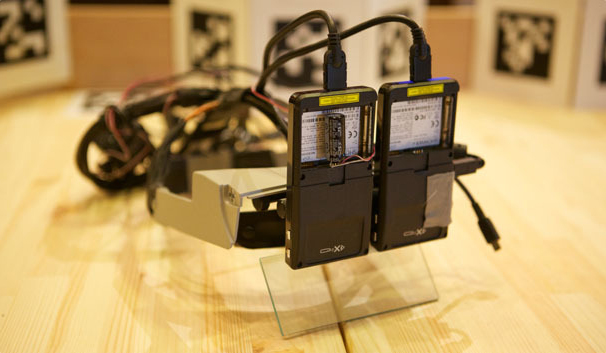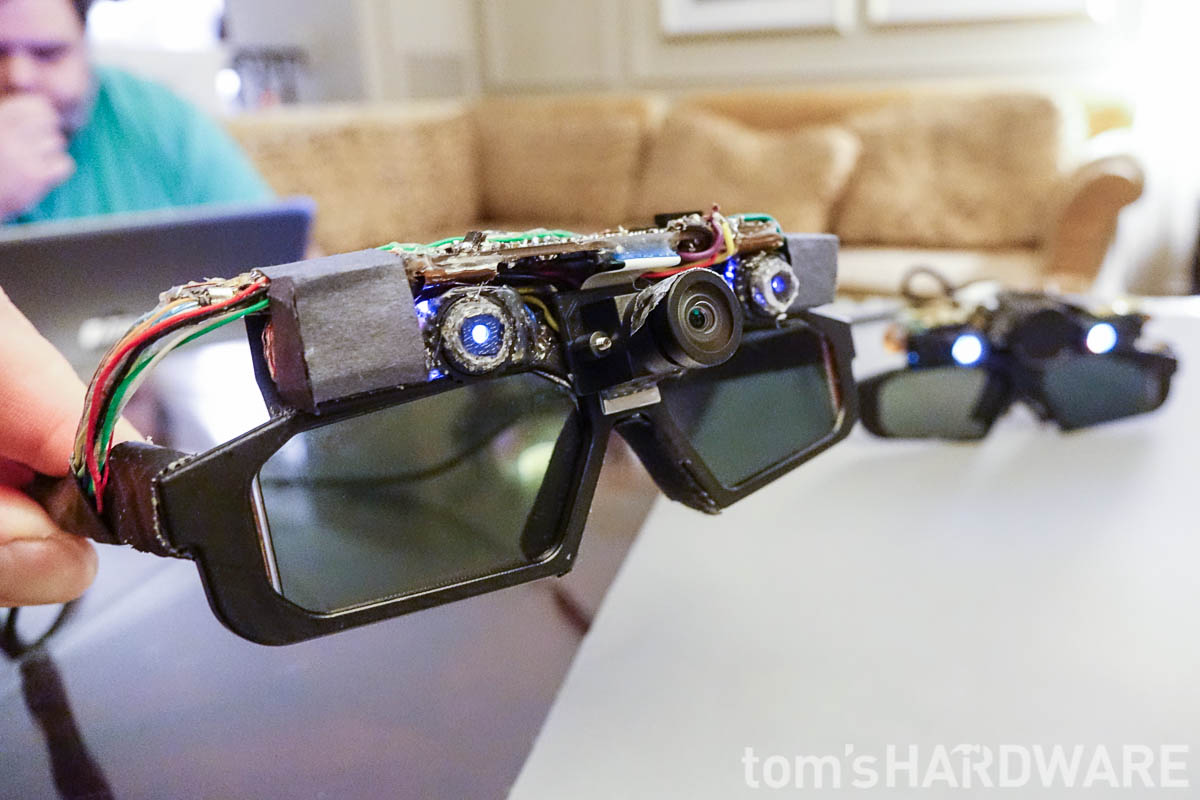CastAR: The Augmented And Virtual Reality Triple-Threat
On our last day at CES 2014, we got to go hands-on with an early prototype of a most interesting pair of Augmented and Virtual Reality glasses. Currently in development, CastAR can project holographic-like 3D imagery right in front of you.
Projected AR: A Happy Accident?
Louis Pasteur once said “chance favors only the prepared mind”. That quote is especially relevant to the story of how Technical Illusions' castAR Projected Augmented Reality glasses came to be. Co-founder Jeri Ellsworth is a hardware hacker, self-taught chip designer, and pinball machine expert. She was one of the first hires at Valve Software’s hardware lab, where she worked on some of the company’s wilder projects, including what eventually became the Steam Controller.
In May of 2012, while experimenting with “near-eye display” Virtual Reality (VR) technology, Jeri accidentally put an optical component in backwards, projecting the image out into the environment. At the same time, there just so happened to be a piece of retro-reflective material (the same stuff that makes street signs glow at night when your headlights hit them) in the lab, which the image was projected onto. When Jeri saw this, she experimented further and realized that projecting Augmented Reality (AR) content, instead of having it close to the eye, could solve a lot of the issues folks have with more traditional AR and VR concepts. While this discovery could be considered happenstance, it still took the right person to understand its true value. One with a “prepared mind”.
It then took another set of fortuitous circumstances to turn that discovery into a product you should be able to buy in 2015. Jeri continued to experiment with projected AR at Valve, building a series of prototypes, starting with the unwieldy, painful-to-wear, and appropriately named “head crab”.
To help her on the software side, Jeri recruited fellow pinball enthusiast Rick Johnson, formerly of Raven Software, Gearbox, and one of the three people who started the Linux cabal at Valve (eventually leading to SteamOS). Over the next six months, they continued to iterate the prototypes, making them smaller and more comfortable to wear. But in a surprising turn of events, in February 2013 both Jeri and Rick found themselves without jobs.
Valve had laid them off, along with a number of other people in the hardware lab. And while a reason was never formally given (Jeri and Rick say that they still don’t know exactly why), it’s possible that their vision for AR glasses just didn’t jive with Valve’s future, which seems to be more focused on VR, especially in light of recent announcements.
Although the pair was no longer working at Valve, they were able to continue improving their AR glasses; Gabe Newell and Valve’s lawyers allowed Jeri and Rick to take the technology with them.
It wasn’t until the May 2013 Bay Area Maker Faire that Jeri and Rick revealed to the world the company they were starting (Technical Illusions) and its brainchild, castAR. After showing off the concept at numerous other trade shows and conventions, slowing building interest, they launched a Kickstarter in October 2013, eventually raising $1.05 million. That was more than double the original goal of $400,000. They heavily involved their backers, and some of the suggestions added to the campaign will later be incorporated into castAR.
Get Tom's Hardware's best news and in-depth reviews, straight to your inbox.
Current page: Projected AR: A Happy Accident?
Next Page Hands-On With The CastAR HD Prototype-
CaedenV This is pretty neat!Back when I was a kid in the '90s my dad use to work for a company that made 3D scanners, and I had the opportunity to follow him one day to go repair a scanner at a college. While there the college students kept me entertained with a system kind of similar to this. It was based on a stereoscopic rear-projection screen, and a set of head tracking polarized glasses. It was pretty cool, and I have been very supprised that we have not seen much like it until now.The other cool thing was that rather than a big funky wand, you basically had 2 handheld devices with buttons under each finger in order to interact with the enviornment. One button would allow you to grab and move an object, another would allow you to rotate, others would bring up context menus, or 'in game' options. It was all really neat.Anywho, the big thing that it was missing (other than good graphics... it was the '90s after all) was the ability to have a multiple users. With multiple users interacting on the same playing field like this new AR can do, it makes for some much more interesting gameplay.I really hope that things like VR and AR are able to take off. When I was a kid I was promised that I could go live in space, and that we would have holodecks available... so far we are 0 for 2, but I would be pretty happy if we could get one or the other off the ground.Reply -
CaedenV Reply12771614 said:Wait, so will this be better than Oculus Rift? I'm really curious now.
Certainly not 'better' in the way of quality. The nice thing about Oculus Rift is that you have a much more controlled enviornment, and are able to surround yourself with a virtural world while blocking out reality. This system is meant to open up more social or alternative styles of gameplay. Much more flexible in what it can do... but it will necessarily always have drawbacks because the environment is less controlled. Ambient light can wash out your characters, resolution on projectors vs a screen are always going to suffer more from things like the screen door effect, and it is much more difficult to cram 2 high resolution projectors in the same space as a single high res monitor.
So it is one of those things where you win some and you loose some. I think the Oculus Rift will have much more of a following for hard core gamers, and even myself as a moderate gamer. But the Rift will always suffer in the popular market because (as is the great secret of Nintendo) people, especially kids (or parents of those kids), enjoy more social games. Things that block reality out have a very difficult time gaining traction. But something like this AR would offer more social interaction. Essentially high tech board and card games, or some sort of choose your own adventure games. I could just imagine something like Warhammer, or D&D being played like this where you can throw down a card or a token and have a 3D character on the field of battle. Or better yet, combine UI hardware like this with a content creator like Project Spark in a school setting to engage students in cooperative programming and game environments!
At any rate, you loose out on quality, but you have the potential to gain in other ways which could be much more interesting than the Rift. Very different devices aimed at very different uses and markets. -
Omid_m_19 Beside D&D and board games that have been mentioned in the article,and I add TCG(Trading card games,like Yu-gi oh and infinity wars),I think other things too will be much fun.For example,by adding kinect,you can play a fighting game,seeing your opponent in front of you,and with kinect monitoring your body actions,you hit or block AI fighter,like real fights.I think it would be very useful in learning martial arts.Reply -
Omid_m_19 Beside D&D and board games that have been mentioned in the article,and I add TCG(Trading card games,like Yu-gi oh and infinity wars),I think other things too will be much fun.For example,by adding kinect,you can play a fighting game,seeing your opponent in front of you,and with kinect monitoring your body actions,you hit or block AI fighter,like real fights.I think it would be very useful in learning martial arts.Reply -
tristangl darn I forgot that you CANNOT hit refresh on Toms pageGuys at Tom... can you fix that stupid bug where it double post your comment if you ever hit F5 once you post somethingShould be already fixed... I mean you are a a tech website are you not??!!?Reply


